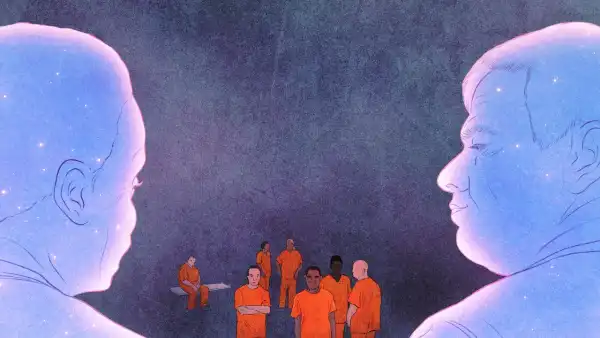
Save this storySave this storySave this storySave this story
The year is 2018. I am in a classroom for the first time at Great Meadow Correctional Facility in Comstock, New York, a maximum-security prison for men. There are sixteen students in the room. They are white, black, and Hispanic. Two are the age of regular college students; most are considerably older. The oldest, a man in his seventies, has difficulty understanding speech through the prison’s cheap hearing aids. All of these men have demonstrated the ability to function at a college level. Several, in fact, already have college degrees. Some have been incarcerated for thirty years or more, and have been reading books the entire time.
My course is called “The History of Thought: The Enlightenment.” I’ve taught it twice before at Bennington College in Vermont, which sponsors our program. We begin with Immanuel Kant and Francis Bacon, then move on to Montesquieu and other French thinkers like Voltaire, Jean-Jacques Rousseau, and Denis Diderot, and end with the Americans: Benjamin Franklin, Thomas Paine, Thomas Jefferson, James Madison. I wanted to begin my teaching career at Great Meadow with this course because our country was founded on Enlightenment principles that many seem to have forgotten. Principles like the separation of powers and the distinction between church and state are not arbitrary concepts but responses to historical circumstances that we must recognize if we are to avoid making the same mistakes again. After our discussion of the Declaration of the Rights of Man and of the Citizen, one of my students, a tall, middle-aged black man, expressed his frustration: “Everyone should take this in high school.” But of course we don’t. In 2022, eighth-grade scores in U.S. history and social studies fell to their lowest levels in three decades.
Great Meadow Prison, which closed last year, housed a significant proportion of men serving life sentences or what is known as “effective life sentences”: sentences of 50 years or more, so long that if a prisoner lives to his release date, he is too old to enjoy the full benefit of his freedom.
A man I’ll call Roger, one of our most dedicated students, was sent to prison at age 18 and is serving a sixty-year sentence; he’s now in his late thirties. (All the students’ names in this article have been changed.) “For better or for worse,” he wrote in an essay, “I am a civilly dead social exile.” Intellectually voracious, Roger spends his free time reading Michel Foucault and Franz Kafka. He earned two associate’s degrees in prison, but after a recent transfer to a facility in Connecticut, he hit a roadblock. Many states explicitly bar lifers and de facto lifers from participating in rehabilitation programs, pursuing higher education, or living outside their cells, favoring those who will one day be released and able to contribute to society.
For some people, however, both inside and out, the development of the intellect is not so simple: it satisfies a deep spiritual need, as important as a religious calling for others. Take Eric, a man in his late fifties who had served nearly thirty-five years in prison and would never be released. I first met him in a course on “Enlightenment.” The officers sometimes prevented people from attending classes, so Eric missed the first class, in which I was giving a talk on the history of the subject. In the second class, I was giving a test to see how well the students had understood the material; I told Eric that since he had missed my lecture, he was exempt from the test. Nevertheless, he asked to take the test anyway and did better than anyone else, even giving the date (1685) of the revocation of the Edict of Nantes! It turned out that he had spent the previous few months studying Descartes.
The benefits of education for individual lifers are obvious, but I am often asked what benefit it brings to anyone else, let alone society at large. The answer is simple: university courses create a community, and the culture of that community spills over into the wider culture of the prison. “Even outside the classroom,” Eric wrote, “you discuss what you read, your ideas, his views on it, your views on it. It creates a community, and everyone in that community enjoys learning.”
When such a community includes lifers, the influence expands. There are many of them: one in seven prisoners in the United States is serving a sentence of fifty years to life. Among people of color in prison, the figure is one in five. And, as Roger noted, “lifers are influential in the prison. In many ways, they are the creators of the ‘prison code’ by which prisoners and guards live… So when a lifer chooses a different way of life and does so successfully, he loosens the chains of the antisocial prison codes. He becomes a beacon of light for those around him.” The truth of this statement had been obvious to me throughout my years of study.
Sourse: newyorker.com






